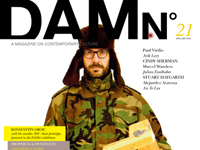
by Lyle Rexer
Looking at the work of Julian Faulhaber is like seeing the world through Tupperware-tinted glasses, the pristine locations he pictures epitomise an artificial landscape. Yet while thay are devoid of human presence, and represent what the photographer calls ‘aggregations of spotlessness’, the sense of manipulation is itself not real and the emotional content far from barren.
In an old episode of the Twilight Zone, a woman trapped in a department store after-hours mistakenly presses an elevator button and finds herself on the 13th floor where the mannequins have come to life. In the end, she becomes one of them. Julian Faulhaber’s photographs evoke just such a sense of the uncanny out-of-place, where the natural becomes artificial (and vice versa).
The Twilight Zone Faulhaber shows us is pristine and devoid of human presence: newly constructed architectural spaces, from basketball courts to petrol stations, prior to their inhabitation and use. The Dortmund-based photographer won the Epson Art Photography Award in 2005, and it’s not hard to see why. The large pictures glow with industrial colour. Faulhaber’s recent New York exhibition at Hasted Hunt was titled Lowdensitypolyethylene, and every location looked as if it had been shot through coloured Tupperware containers. His sports court glowed pink, a stairwell orange, a lounge pill-green. The environments are fabricated of artificial, not to say toxic, materials and Faulhaber’s treatment underscores their origin. Like photographs themselves, these places were all produced seemingly without human agency – from a machine.
Honest & False
Faulhaber is usually compared to his German contemporaries Andreas Gursky and Thomas Demand. No question all these photographers are obsessed with the built environment and what it means – politically, historically and ontologically. But Gursky and Demand in their different ways create fictional spaces, through digital manipulation on the one hand and the fabrication of cardboard interiors (based on actual settings) on the other. They and Thomas Struth make a problem out of what and how we see. Faulhaber plays it much straighter, never manipulating the colour or geometry of the 4’ x 5’ images. The unsettling result is honest photographs that look false, as if they were generated by a computer.
One of Faulhaber’s gigantic images, depicting a pristine petrol station ready for its first cars and credit cards, was the outsize star of another recent exhibition, Reality Check: Truth and Illusion in Contemporary Photography at New York’s Metropolitan Museum of Art. Even under close examination, it was almost impossible to tell whether one was having a photographic experience or looking at a painting by Ed Ruscha.
Faulhaber finds these ‘aggregations of spotlessness’, as he calls them, by prospecting. He drives the streets, roams shopping malls and car rental agencies. He scours architectural and design magazines for clues and makes a beeline to the sources he targets. He first began looking at the world this way as a student at the University for Photography in Dortmund, under the influence of pop art’s bright colours and plastic surfaces. Increasingly he saw life imitating art. By now he knows just the kind of sites he likes: ‘the place has to be really new and the structure of the materials has to be polished and clean. The light has to imbue the space with a highly artificial atmosphere,’ he adds. ‘I do not photograph with additional light.’
Mannequin Desire
The disturbing quality of Faulhaber’s vacu-formed world has less to do with its geometry than with its emotional temperature. That might seem at first glance to approach absolute zero, but not in the photographer’s mind. ‘These spaces have the aim of satisfying human needs,’ he says. ‘At a poignant moment of perfection between their completion by the contractors and the arrival of their first users, the aim seems to be at its highest level. There is a polished gleam from the clean surfaces yet to be scuffed by the users for whom they are intended.’ His world is one of intense desire but desire antiseptically satisfied; mannequin desire, corporate architecture’s version of the zipless fuck.
As if this weren’t alienating enough, photography itself plays a role in these spotless fantasies. According to Faulhaber, contemporary photography depicts ‘the opposite of nature, but perhaps it satisfies the desire for nature.’ That desire is for ‘something pristine and untouched, a clean image of the world,’ which is mirrored in the faultless, uniform surface of the photograph itself. The gigantic colour print provides a spectacle, a panorama of some other reality that could also be our own. The scale makes it seem that the things these images depict haven’t quite happened yet, that they are not just incomplete but imaginary.
Nature and Culture
Yet they are all too real, and behind the pictures’ utopian clarity lies a dystopian chaos. The amount of plastics produced in the United States alone – including low-density polyethylene – has doubled over the last 20 years, and the fragments of that clean new world keep flaking off and finding their way not just into landfills but into the oceans. Vast areas of the Pacific have become floating garbage dumps, carrying everything from syringes and cell phones to office furniture, and plasticised Bermuda Triangles as multicoloured as any photo from Dusseldorf or Dortmund. Looking at Faulhaber's images, it is impossible to imagine tomorrow's spaces ever growing old or decaying. Yet they will break down, intensifying the age-old battle between nature and culture, as we furiously attempt to figure out what can possibly be done to keep the world pristine. We could imagine, then, that if Faulhaber is still making photographs in another 40 years he'll have a whole new set of uninhabited places to depict. But these won't be waiting for a human presence to occupy them. The humans will long since have departed, to be replaced by the new version of an owner, perhaps a mannequin or a robot made of plastic.